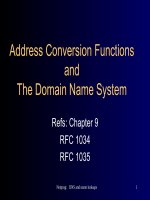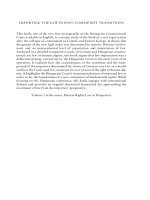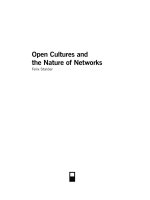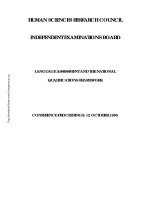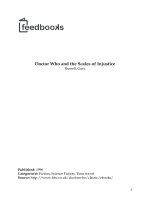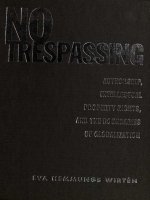CONSTITUTIONAL LAW AND THE CRIMINAL JUSTICE SYSTEM doc
Bạn đang xem bản rút gọn của tài liệu. Xem và tải ngay bản đầy đủ của tài liệu tại đây (4.84 MB, 451 trang )
CONSTITUTIONAL LAW
AND THE
CRIMINAL JUSTICE SYSTEM
J. SCOTT HARR, JD
Concordia University Saint Paul
KÄREN M. HESS, PhD
Normandale Community College
with contributions from
Christine Hess Orthmann, MS
Fourth Edition
Australia • Brazil • Canada • Mexico • Singapore • Spain • United Kingdom • United States
Constitutional Law and the Criminal Justice System, Fourth Edition
J. Scott Harr and Kären M. Hess
Acquisitions Editor: Carolyn Henderson Meier
Assistant Editor: Meaghan Banks
Editorial Assistant: Beth McMurray
Technology Project Manager: Amanda Kaufmann
Marketing Manager: Terra Schultz
Marketing Assistant: Emily Elrod
Marketing Communications Manager: Tami Strang
Project Manager, Editorial Production: Matt Ballantyne
Creative Director: Rob Hugel
Art Director: Vernon Boes
Print Buyer: Linda Hsu
Permissions Editor: Roberta Broyer
Production Service: Graphic World Inc.
Photo Researcher: Terri Wright
Copy Editor: Graphic World Inc.
Cover Designer: Yvo Riezebos
Cover Image: istockphoto.com/
©
Stefan Klein
Compositor: ICC Macmillan Inc.
Text and Cover Printer: West Group
©
2008, 2005 Thomson Wadsworth, a part of The Thomson
Corporation. Thomson, the Star logo, and Wadsworth are
trademarks used herein under license.
ALL RIGHTS RESERVED. No part of this work covered
by the copyright hereon may be reproduced or used in any
form or by any means—graphic, electronic, or mechanical,
including photocopying, recording, taping, Web distribution,
information storage and retrieval systems, or in any other
manner—without the written permission of the publisher.
Printed in the United States of America
12345671110090807
Library of Congress Control Number: 2007922063
Student Edition:
ISBN-13: 978-0-495-09543-9
ISBN-10: 0-495-09543-5
Thomson Higher Education
10 Davis Drive
Belmont, CA 94002-3098
USA
For more information about our products, contact us at:
Thomson Learning Academic Resource Center
1-800-423-0563
For permission to use material from this text or product,
submit a request online at .
Any additional questions about permissions can be
submitted by e-mail to
Dedicated to Captain Steven Simmons (1943–1995), Minneapolis Police
Department. Steve Simmons lived the law and upheld the U.S. Constitution
through his work as a police officer and educator. But more importantly, Steve
was a friend. He embodied every attribute of the professional law enforcement
officer, and he is sorely missed by the community he served,
his students, his friends and his family.
May you always have blue skies, a pleasant breeze and good sailing.
iv
J. Scott Harr’s interest in the law spans over 30 years from varied perspectives. He
has been employed as a social worker in youth diversion programs, has proudly
served as a police officer for three Twin Cities metropolitan communities and as
public safety director and chief law enforcement officer of one of these. He has
taught classes in all areas of the law for more than 20 years. While attending
William Mitchell College of Law in St. Paul, Minnesota, he received the Warren
E. Burger Award given in honor of the former chief justice of the U.S. Supreme
Court. He also attended Emmanuel College, Cambridge University (England),
where he studied law. Harr has worked as a staff investigator for a preeminent
Twin Cities law firm and is a member of the U.S. Supreme Court bar, placing him
among attorneys permitted to practice before the Supreme Court. He is a licensed
attorney, police officer and private investigator. He founded Scott Harr Legal
Investigations, which has been in business for over 20 years. In addition to this
text, he has coauthored and contributed to numerous other titles. Scott has
taught at Normandale Community College in Bloomington, Minnesota, and
Metropolitan State University School of Law Enforcement and Criminal Justice in
St. Paul, Minnesota. He is presently the chair of the criminal justice department
at Concordia University, Saint Paul, Minnesota, and sits on the Minnesota Peace
Officer Standards and Training (POST) Board, where he also chairs the board’s
training committee.
Kären M. Hess holds a PhD in English and in instructional design from the
University of Minnesota and a PhD in criminal justice from Pacific Western
University. Other Wadsworth Thomson Learning texts Dr. Hess has coauthored are
Careers in Criminal Justice and Related Fields (Fifth Edition), Criminal Investigation
(Eighth Edition), Criminal Procedure, Corrections in the 21st Century: A Practical
Approach, Introduction to Law Enforcement and Criminal Justice (Eighth Edition),
Introduction to Private Security (Fifth Edition), Juvenile Justice (Fourth Edition),
Management and Supervision in Law Enforcement (Fourth Edition), Community Polic-
ing: Partnerships for Problem Solving (Fourth Edition), and Police Operations: Theory
and Practice (Fourth Edition).
She is a member of the Academy of Criminal Justice Sciences, the American
Association of University Women, the American Correctional Association, the
American Society for Industrial Security, the American Society for Law Enforce-
ment Trainers, the American Society of Criminologists, the Association for Super-
vision and Curriculum, the International Association of Chiefs of Police, the
Minnesota Association of Chiefs of Police, the Police Executive Research Forum
and the Text and Academic Authors Association, which has named Dr. Hess to
their Council of Fellows.
About the Authors
v
Section I: A Foundation for Understanding
Constitutional Law 1
Chapter 1 An Historical Overview 3
Chapter 2 An Overview of the U.S. Legal System 35
Chapter 3 The Supreme Court of the United States:
The Final Word 58
Chapter 4 Researching the Law 76
Section II: The Guarantees of the Constitution
to Citizens: Civil Rights and Civil Liberties 91
Chapter 5 Equal Protection under the Law: Balancing
Individual, State and Federal Rights 93
Chapter 6 The First Amendment: Basic Freedoms 120
Chapter 7 The Second Amendment: The Gun Control
Controversy 149
Section III: Constitutional Amendments Influencing
the Criminal Justice System 171
Chapter 8 The Fourth Amendment: An Overview of
Constitutional Searches and Seizures 173
Chapter 9 Conducting Constitutional Seizures 202
Chapter 10 Conducting Constitutional Searches 228
Chapter 11 The Fifth Amendment: Due Process and Obtaining
Information Legally 266
Chapter 12 The Sixth Amendment: Right to Counsel
and a Fair Trial 298
Chapter 13 The Eighth Amendment: Bail, Fines and Punishment 323
Brief Contents
Section IV: Coming Full Circle 349
Chapter 14 The Remaining Amendments and a Return to the
Constitution 351
Epilogue 367
Appendixes 369
Glossary 402
Author Index 409
Subject Index 410
vi Brief Contents
SECTION I
A Foundation for Understanding
Constitutional Law 1
Chapter 1 An Historical Overview 3
Introduction 4
Where It All Began 5
Contributions from the Past 5
The Mayflower Compact 6
The Great Melting Pot 6
Development of the United States of America 8
Colonial Dissension Grows 8
The First Continental Congress 10
The Tension Mounts 10
The Revolution Begins 11
The Second Continental Congress 11
The Declaration of Independence 12
What It Cost the Signers 13
The Articles of Confederation 14
The Influence of the Magna Carta 15
The Influence of English and French Philosophers 15
The 1787 Convention of Delegates—A Move toward the
Constitution 16
The Constitution Takes Shape 17
The Issue of Slavery 19
Drafting the Constitution 19
The Constitution of the United States: An Overview 20
Article 1—The Legislative Branch 20
Article 2—The Executive Branch 21
Article 3—The Judicial Branch 22
Article 4—Other Provisions 22
Article 5—The Amendment Process 23
Article 6—The Constitution as the Supreme Law 23
The Signing of the Constitution 23
Ratification 24
A Balance Is Struck with the Bill of Rights 25
The Bill of Rights: An Overview 27
A Living Law 30
A Nearly Timeless Document 30
Where the Declaration of Independence and Constitution
Are Today 31
Contents
vii
Federalism at Work in the Criminal Justice System 31
Summary 32
Discussion Questions 33
InfoTrac College Edition Assignments 34
Internet Assignments 34
Companion Web Site 34
References 34
Additional Resources 34
Cases Cited 34
Chapter 2 An Overview of the U.S. Legal System 35
Introduction 36
Theories about and the Purpose of the Legal System 37
The Law Defined 39
Development of the Law 39
Stare Decisis 40
The Continuing Need for Law 41
American Law Lives 41
Categorizing Law 42
Who? (Jurisdiction) 42
How? (Procedural) 43
What? (Criminal or Civil) 43
The Components of the U.S. Legal System 44
The Court System 45
The State Court System 45
The Federal Court System 48
Officers of the Court 50
An Adversarial Judicial System 50
Doctrines Governing What Cases Will Be Heard 51
The Constitution and Criminal Justice in the United States: The Big Picture 52
The Courts, Corrections and Criminal Sanctions 52
The Juvenile Justice System 52
The Criminal Justice and Juvenile Justice Systems Compared 53
The Changing Face of American Criminal Justice and Constitutional Law 54
American Criminal Justice beyond Our Borders 54
Summary 55
Discussion Questions 56
InfoTrac College Edition Assignments 56
Internet Assignments 56
Companion Web Site 57
References 57
Additional Resources 57
Cases Cited 57
Chapter 3 The Supreme Court of the United States:
The Final Word 58
Introduction 59
Authority for the Supreme Court 60
viii Contents
Jurisdiction of the Supreme Court 60
Judicial Review 63
Controversy over and Alternatives to Judicial Review 64
Certiorari: Deciding Which Cases to Hear 65
The Supreme Court Justices 65
The Influence of the Supreme Court on the
Justice System 68
The Current Supreme Court 68
Politics and the Supreme Court 70
Traditions and Procedures 71
Opinions 72
Interpretations 72
Where Supreme Court Decisions May Be Found 73
The Power of the Supreme Court 73
Summary 73
Discussion Questions 74
InfoTrac College Edition Assignments 74
Internet Assignments 74
Companion Web Site 74
References 74
Cases Cited 75
Chapter 4 Researching the Law 76
Introduction 77
The Importance of Knowing How to Research the Law 78
Popular, Scholarly and Professional Sources 78
Primary and Secondary Sources 80
Primary Information Sources 80
Secondary Information Sources 80
Reading Legal Citations 81
Case Law 82
Reading Case Law 82
Skills Required to Read a Case 84
Briefing a Case 84
Brief of Marbury v. Madison 85
Brief of Miranda v. Arizona 85
Shepardizing 86
Computerized Legal Research 86
CDs and DVD Data 87
The Internet 87
The Law on the Web 87
Information Literacy 88
What’s Next? 89
Summary 89
Discussion Questions 90
InfoTrac College Edition Assignments 90
Internet Assignment 90
Companion Web Site 90
References 90
Resources 90
Cases Cited 90
Contents ix
SECTION II
The Guarantees of the Constitution to Citizens:
Civil Rights and Civil Liberties 91
Chapter 5 Equal Protection under the Law: Balancing
Individual, State and Federal Rights 93
Introduction 94
The Thirteenth Amendment 95
The Fourteenth Amendment 96
Discrimination versus Prejudice 98
The Roots of Racial Discrimination 98
The Issue of “Separate but Equal” 99
The Struggle for Equality 100
The Rise of Affirmative Action Programs 101
Reverse Discrimination 103
Other Forms of Discrimination 103
Equality in the Twenty-First Century 106
Equal Protection in the Criminal Justice System 106
Discrimination in Law Enforcement 107
Discrimination in the Courts 109
Discrimination in Corrections 111
Is There Systematic Discrimination in the Criminal
Justice System? 114
Balancing State and Federal Power and Individual Rights 114
Selective Incorporation 115
A Check on Federal Power 116
Summary 116
Discussion Questions 117
InfoTrac College Edition Assignments 118
Internet Assignments 118
Companion Web Site 118
References 118
Cases Cited 119
Chapter 6 The First Amendment: Basic Freedoms 120
Introduction 121
Freedom of Religion 122
The Establishment Clause 123
The Free Exercise Clause 126
Interpretations 129
Freedom of Speech 129
Restrictions on Freedom of Speech 130
Somewhat Protected Speech 134
First Amendment Expression Rights of Police Officers 139
Freedom of the Press 140
Balancing Freedom of the Press with the Right to a Fair Trial 142
The Right to Peaceful Assembly 143
First Amendment Rights of Prisoners 145
Summary 146
Discussion Questions 147
x Contents
InfoTrac College Edition Assignments 147
Internet Assignment 147
Companion Web Site 147
References 147
Additional Resources 148
Cases Cited 148
Chapter 7 The Second Amendment:
The Gun Control Controversy 149
Introduction 150
Historical Background 151
The Debate: Interpreting the Second Amendment 152
Individual Rights versus States’ Rights 152
Current Legal Status of the Nonincorporated Second
Amendment 153
Case Law and the Second Amendment 154
States and the Second Amendment 155
Concealed/Carry, or Right-to-Carry, Laws 156
Restrictions on Types of Firearms 157
An Evaluation of State Gun Laws 157
Federal Regulation and the Second Amendment 158
The Brady Act 160
The Violent Crime Control and Law Enforcement
Act of 1994 161
The Law Enforcement Officers Safety Act 161
The Current Gun Control Controversy 162
In Opposition to Gun Control 162
In Support of Gun Control 163
Finding Common Ground—Is a Compromise Possible? 164
Broadening of the Debate 165
Joint Government and Community Efforts to Respond
to Gun-Related Violence 165
A Final Consideration: Gun Control as a Political Issue 166
Summary 167
Discussion Questions 168
InfoTrac College Edition Assignments 168
Internet Assignments 168
Companion Web Site 168
References 168
Cases Cited 169
SECTION III
Constitutional Amendments Influencing
the Criminal Justice System 171
Chapter 8 The Fourth Amendment: An Overview
of Constitutional Searches and Seizures 173
Introduction 174
The Importance of the Fourth Amendment to Law Enforcement 176
Who Is Regulated by the Fourth Amendment? 177
Contents xi
The Clauses of the Fourth Amendment 178
Two Interpretations 178
Reasonableness 179
Right to Privacy 180
Probable Cause 180
Sources of Probable Cause 181
Search and Arrest Warrants 184
Special Conditions 184
Executing the Search Warrant 185
The Continuum of Contacts 185
The Law of Stop and Frisk 187
Basic Definitions 188
Terry v. Ohio 189
Consequences of Fourth Amendment Violations 190
The Exclusionary Rule 190
Is the Court Anti–Law Enforcement? 194
Exceptions to the Exclusionary Rule 194
Internal Sanction, Civil Liability and Criminal Liability 198
Summary 199
Discussion Questions 200
InfoTrac College Edition Assignments 200
Internet Assignments 200
Companion Web Site 200
References 200
Additional Resource 201
Cases Cited 201
Chapter 9 Conducting Constitutional Seizures 202
Introduction 203
What Gives Police the Right? 204
Investigatory Stops 204
Traffic Stops 207
Stops at International Borders and Checkpoints 209
An Arrest or Not? 212
Arrests 213
An Arrest and a Stop Compared 214
The Elements of an Arrest 214
When Arrests May Be Lawfully Made 214
Warrantless Arrests for Crimes Committed in the Presence
of an Officer 215
Warrantless Arrests Based on Probable Cause 215
Arrests with a Warrant 216
Where Arrests May Be Made 216
The Knock and Announce Rule 217
Fresh and Hot Pursuit 220
Use of Force in Making an Arrest 221
What Is Reasonable Force? 222
Use of Deadly Force 223
Citizen’s Arrest 224
Rights of Those in Custody 224
Immunity from Arrest 225
Summary 225
xii Contents
Discussion Questions 226
InfoTrac College Edition Assignments 226
Internet Assignments 226
Companion Web Site 226
References 227
Cases Cited 227
Chapter 10 Conducting Constitutional Searches 228
Introduction 229
Tenets of Fourth Amendment Search Analysis 230
The Scope of Searches 230
Searches with a Warrant 231
Administrative Warrants 234
Searches without a Warrant 235
Searches with Consent 235
Frisks 238
Plain Feel/Plain Touch 239
Plain View Evidence 240
Searches Incident to Lawful Arrest 242
The Automobile Exception 247
Exigent Circumstances 250
Open Fields, Abandoned Property and Public Places 251
Border Searches and Seizures 253
Electronic Surveillance and the Fourth Amendment 256
The Fourth Amendment and Corrections 259
Institutional Corrections 259
Community Corrections 260
Summary 262
Discussion Questions 263
InfoTrac College Edition Assignments 263
Internet Assignments 263
Companion Web Site 264
References 264
Additional Resource 264
Cases Cited 264
Chapter 11 The Fifth Amendment: Due Process
and Obtaining Information Legally 266
Introduction 267
Government’s Need to Know 269
The Right against Self-Incrimination 269
Due Process of Law 269
The Fifth Amendment and Confessions 271
Voluntariness of Confessions 271
Miranda 274
The Case 274
The Miranda Warning 275
When the Miranda Warning Must Be Given 276
Waiving the Rights 278
Beachheading or “Question First” 279
Contents xiii
Miranda Survives a Challenge—Dickerson v. United States 279
Miranda Issues Continue 280
When Miranda Warnings Generally Are Not Required 281
The Public Safety Exception 282
The Interplay between the Fourth and Fifth Amendments 283
Using Informants 284
Entrapment 285
Other Rights Guaranteed by the Fifth Amendment 286
The Right to a Grand Jury 287
Double Jeopardy 288
Just Compensation 289
Fifth Amendment and Corrections 290
USA PATRIOT Act 290
Allowing Use of Already Available Tools 291
Facilitating Information Sharing and Cooperation among Government
Agencies 292
Updating the Law to Reflect New Technologies and New Threats 292
Increasing Penalties for Those Who Commit or Support Terrorist Crimes 292
The Renewal of the USA PATRIOT Act 293
The USA PATRIOT Act and a Changing Society 294
Summary 294
Discussion Questions 295
InfoTrac College Edition Assignments 295
Internet Assignments 295
Companion Web Site 295
References 295
Cases Cited 296
Chapter 12 The Sixth Amendment: Right to Counsel
and a Fair Trial 298
Introduction 299
Speedy and Public Trial 300
Where the Trial Is Held 301
An Impartial Jury 302
Jury Nullification 304
Being Informed of the Accusation 304
The Right to Confront Witnesses 304
Compulsory Process 305
Right to Counsel 305
The Role of Counsel 305
Development of the Right to Counsel 306
Right to Counsel at Critical Stages of Criminal Proceedings 309
Critical Stages during the Criminal Investigation 310
Rights during Identification 311
Critical Stages at Hearings, Trials and Appeals 313
The Presumption of Effective Counsel 316
Waiver of Sixth Amendment Right to Legal Counsel 317
The Right to Act as One’s Own Counsel 317
Juveniles and the Sixth Amendment 319
The Sixth Amendment and Corrections 319
Summary 320
Discussion Questions 321
xiv Contents
InfoTrac College Edition Assignments 321
Internet Assignments 321
Companion Web Site 321
References 321
Cases Cited 321
Chapter 13 The Eighth Amendment: Bail, Fines
and Punishment 323
Introduction 324
A Brief History of Punishment 325
Bail 326
The Evolution of Legislation and Case Law on Bail 326
Fines 329
Asset Forfeiture and the Prohibition against Excessive Fines 330
Cruel and Unusual Punishment 331
Punishment Options 333
Physical Forms of Punishment 333
Capital Punishment 334
Is Capital Punishment Cruel and Unusual? 336
Means of Execution 338
Who Can Be Executed? 339
Appeals 341
Juries and Capital Punishment Cases 341
Continuing Controversy 342
The Eighth Amendment and Corrections 342
Prisoner Treatment and the Eighth Amendment 343
Summary 345
Discussion Questions 345
InfoTrac College Edition Assignments 346
Internet Assignments 346
Companion Web Site 346
References 346
Cases Cited 346
SECTION IV
Coming Full Circle 349
Chapter 14 The Remaining Amendments and a Return
to the Constitution 351
Introduction 352
The Remaining Amendments of the Bill of Rights 352
The Third Amendment 353
The Seventh Amendment 353
The Ninth Amendment 354
The Tenth Amendment 357
Amendments beyond the Bill of Rights 360
The Eleventh Amendment (1798) 360
The Thirteenth Amendment (1865) 360
The Fourteenth Amendment (1868) 360
Amendments Related to Elections and Structure of Congress 362
Contents xv
Voting Rights 363
Taxes 363
Prohibition 363
Attempts at Other Amendments 364
Summary 365
Discussion Questions 365
InfoTrac College Edition Assignments 366
Internet Assignments 366
Companion Web Site 366
References 366
Cases Cited 366
Epilogue 367
Appendixes
Appendix A The Declaration of Independence 369
Appendix B The United States Constitution and Amendments 372
Appendix C Marbury v. Madison and Miranda v. Arizona 384
Glossary 402
Author Index 409
Subject Index 410
xvi
Contents
Chapter 1 Chapter Title xvii
xvii
Foreword
Jim Ramstad, Minnesota, 3rd District
U.S. House of Representatives
More than two centuries ago, our nation’s brilliant and visionary founders wrote
a truly remarkable document that has withstood the test of time and flourished
as an example for new democracies around the world—our Constitution. All
Americans should be very proud of our nation’s steadfast approach to upholding
the guiding principles as written in the Constitution.
Today our 200-plus-year-old Constitution is just as relevant as it was in 1787.
The new, fourth edition of Constitutional Law and the Criminal Justice System does
a masterful job of explaining why. As this tremendous resource clearly shows, we
must give great credit to the visionaries who drafted our Constitution. Although
you can read the Constitution in a matter of minutes, you will not appreciate its
wonders until you examine each word, phrase and clause. That’s what Constitu-
tional Law and the Criminal Justice System accomplishes so well. One person’s
interpretation of the Constitution will differ greatly from another’s. So, too, does
one generation’s interpretation differ from another’s. That is why the study of
constitutional law is a never-ending process. The America of the 21st century dif-
fers markedly from that of 1787. The challenges America faces today simply
didn’t exist in earlier times. And the challenges of change are occurring at a faster
rate and are affecting more and more people because of technology.
As a Member of Congress and former constitutional law professor at
American University, I am a firm believer in our Constitution and how it has
worked to help all people receive fair and just treatment. I am filled with wonder
at how our Constitution still applies so effectively to Americans’ lives today.
I highly commend J. Scott Harr and Kären M. Hess for writing this fourth edi-
tion of Constitutional Law and the Criminal Justice System. This outstanding text on
constitutional law will greatly expand readers’ appreciation for our Constitution’s
amazing durability. The authors have done all Americans a tremendous public
service.
William Finney
St. Paul (Minnesota) Chief of Police (retired)
The authors of this text have accomplished something that was heretofore diffi-
cult to achieve: combining the philosophy of a complicated subject with its prac-
tical application. The U.S. Constitution, as important as it is to every citizen—
especially those employed in the criminal justice system—is not easy to fully
grasp. The mountains of case law arising from efforts to interpret the Constitu-
tion’s “true meaning” are evidence to this. It can be even more challenging for
those working in the field to apply it properly, often with only a split second to
evaluate the circumstances and react.
Young police officers may think that comprehension of the U.S. Constitution
is beyond them because they are not lawyers. Others might think the odds are
against their being immersed in an action or incident that could evolve to the
level of review by the U.S. Supreme Court. They would be wrong on both counts.
Criminal justice professionals are expected to know the law and to apply it, as the
very next call could result in a pivotal case before the Court. This is part of the
excitement and responsibility of our profession.
Professor Harr and Dr. Hess have succeeded at presenting this lofty subject in
an understandable, hands-on manner that would, frankly, benefit every American
to review. It is apparent they have lived, worked and taught what they write
about. Criminal justice professionals, whether newly hired or seasoned cops, cor-
rectional officers, probation officers or employed in any other area of our crimi-
nal justice system, will particularly benefit from the subject matter of this book
and the masterful way it is presented.
xviii
Foreword
xix Chapter 1 An Historical Overview
Preface
This text is unlike most traditional legal works and was prepared this way
intentionally.
Our teaching experience and feedback from students and educators alike gave
us the strong sense that there was a need for something other than a traditional
casebook approach to learning “con law.” While there is certainly a place for tra-
ditional texts, people with whom we consulted wanted a text that fell between
basic civics books and law school-level casebooks to use in their introductory
undergraduate courses on constitutional law or search and seizure. For those who
want an easy, painless journey through the fascinating study of American consti-
tutional law, Constitutional Law and the Criminal Justice System will, we believe,
prove an ideal solution.
Approach
We created this text with the express intent of making the learning of constitu-
tional law as enjoyable and productive as possible. We have developed a natural
progression to help students build their knowledge. Even the layout was done in
a way that will make the learning less tedious. You will notice lots of white space
to make the reading easier, with enough space to make notes or references as you
proceed. Plain language is preferred to legalese. Court opinions are important,
and you will have opportunities in this text to learn how to read them and, in
fact, read and brief some.
Finally, be aware that mastering the basic concepts of constitutional law is
only the beginning. American law is unique in that it can, and does, change to
meet the changing needs of the society it serves. A part of the knowledge you will
acquire is how to keep current with this changing, constantly evolving area of
law. American constitutional law is not a stagnant, boring subject; it is a vital,
stimulating topic that is arguably the duty of every American to know . . . and to
appreciate.
Organization
Section I provides a foundation for understanding constitutional law beginning
with an historical overview of how the Constitution came to be (Chapter 1). This
is followed by an overview of our legal system (Chapter 2) and an explanation of
the Supreme Court of the United States as the final word on any legal issues
(Chapter 3). The section concludes with a description of how to research the law
(Chapter 4).
xix
Section II focuses on the guarantees of the Constitution to citizens: their civil
rights and civil liberties. The discussion first focuses on equal protection under
the law and efforts to balance individual, state and federal rights (Chapter 5). The
focus then shifts to the basic freedoms guaranteed by the First Amendment
(Chapter 6). This section concludes with a discussion of the gun control contro-
versy arising from the Second Amendment (Chapter 7).
Section III describes in depth the constitutional amendments influencing the
criminal justice system. It begins with an overview of constitutional searches and
seizures as required by the Fourth Amendment (Chapter 8). A detailed look at con-
ducting constitutional seizures is presented next (Chapter 9), followed by an
equally detailed look at conducting constitutional searches (Chapter 10). Next is a
discussion of due process and obtaining information legally as required by the
Fifth Amendment (Chapter 11), followed by citizens’ right to counsel and a fair trial
as required by the Sixth Amendment (Chapter 12). The section concludes with a
discussion of bail, fines and punishment as regulated by the Eighth Amendment
(Chapter 13).
The final section of the text provides a discussion of the remaining amendments
and how additional amendments might come to be in the future (Chapter 14).
New to This Edition
The fourth edition of Constitutional Law and the Criminal Justice System has been
completely updated with the most recent Supreme Court decisions and refer-
ences available. Each chapter has been revised and updated as follows:
a
Chapter 1: An Historical Overview This chapter covers important background
information on events leading up to and viewpoints shaping the Constitution,
including the Mayflower Compact, the concept of the Great Melting Pot, the
influence of English and French philosophers (Thomas Hobbes, John Locke,
Montesquieu, Voltaire), the issue of slavery, and the establishment of a balance
of power through federalism. Expanded material is also provided on the Articles
of the Constitution (Clinton v. Jones, 1997; Nixon v. United States, 1993).
a
Chapter 2: An Overview of the U.S. Legal System This updated summary
of the U.S. criminal justice system includes expanded coverage of the compo-
nents of this system, particularly courts and corrections, trends in the juvenile
justice system and a new discussion of how U.S. constitutional law is being
challenged by the blurring of jurisdictional boundaries worldwide.
a
Chapter 3: The Supreme Court of the United States: The Final Word
The concept of federalism is explored in greater detail, as well as how the
separation of powers impacts the workings and opinions of the court. The
chapter also includes a new section on the controversy over and alterna-
tives to judicial review, a comparison of the Rehnquist and the Warren
Courts, and a profile of the current Supreme Court and the politics of
recent decisions.
a
Chapter 4: Researching the Law Expanded coverage of LEXIS/NEXIS is
included in this chapter, as well as additional discussions on the methodol-
ogy of legal writing in general and case briefs in particular, the growing impor-
tance of “information literacy” in relation to current computerized research
methods, and the limitations of the Internet and distinguishing between good
and bad Web sites.
xx
Preface
a
Chapter 5: Equal Protection under the Law: Balancing Individual, State and
Federal Rights This chapter has been expanded to reflect the myriad consti-
tutional challenges presented by our increasingly diverse society, including
more in-depth discussions on race-based admissions policies, affirmative
action and the struggle for equality (Bradwell v. Illinois, 1873), and greater cov-
erage of discrimination and civil rights laws pertaining to other social statuses
such as age (Massachusetts Board of Retirement v. Murgia, 1976), disability, sexual
orientation, religion (Ansonia Board of Education v. Philbrook, 1986), immigra-
tion and residency status (Shapiro v. Thompson, 1969; Plyler v. Doe, 1982;
Sugarman v. McDougall, 1973; and Hampton v. Mow Sun Wong (1976), and
pregnancy policies. Other relevant cases include Duncan v. Louisiana (1968),
Gratz et al. v. Bollinger et al. (2003) and Grutter v. Bollinger et al. (2003).
a
Chapter 6: The First Amendment: Basic Freedoms Updated topics include
difficulties in defining “religion,” the Establishment Clause and the ongoing
struggle between changing norms and constitutional interpretations, includ-
ing court-ordered treatment in which an element of religion exists (Abinton
School District v. Schempp, 1963; Murray v. Curlett, 1963; Wallace v. Jeffries,
1985; Griffin v. Coughlin, 1998; Kerr v. Farrey, 1996; Warner v. Orange County
Dept. of Probation, 1999), freedom of speech and the Internet (United States v.
American Library Association, 2003), free speech restrictions (Gertz v. Robert
Welch, Inc., 1974), cross burning (Virginia v. Black, 2003) and flag burning
(Street v. New York, 1969; Texas v. Johnson, 1989), freedoms of expression and
association (Richmond Newspapers, Inc. v. Virginia, 1980; Chicago v. Morales,
1999; Kelley v. Johnson, 1976; Wilson v. Swing, 1978), and the First Amend-
ment rights of prisoners.
a
Chapter 7: The Second Amendment: The Gun Control Controversy In
addition to updated coverage concerning state and federal legislation, new
topics include the effect of concealed carry laws on crime, the Law Enforce-
ment Officers Safety Act, and joint government and community efforts to
respond to gun-related violence. Newly cited cases involve the issues of gun
ownership by persons convicted in foreign courts (Small v. United States,
2005) and anonymous tips where gun possession is reported (Florida v. J.L.,
2000; Pennsylvania v. D.M., 2000).
a
Chapter 8: The Fourth Amendment: An Overview of Constitutional
Searches and Seizures Updates to this chapter include discussions on indi-
viduals’ right to privacy (Eisenstadt v. Baird, 1972; Griswold v. Connecticut,
1965; Roe v. Wade, 1973), fleeing from police; internal sanctions: civil and
criminal liability of government agents; the evolving challenges to privacy
rights in the wake of terrorist attacks and debates over means of obtaining
information. New material also involves the cases of Illinois v. McArthur
(2001); Maryland v. Garrison (1987); Taylor v. Alabama (1982) and United
States v. Arvizu (2002).
a
Chapter 9: Conducting Constitutional Seizures New coverage includes a
look at the authority that grants police the power to do what they do; more
in-depth coverage of investigatory stops; how concerns over terrorism have
impacted border stops and checkpoints; de facto arrests; changes to the
knock-and-announce rule; the intertwined issues of racism, police brutality
and use of force; the rights of those held in custody; and the cases of
Almeida-Sanchez v. United States (1973), Saucier v. Katz (2001), United States
Preface xxi
v. Flores-Montano (2004), United States v. Montoya de Hernandez (1985),
Atwater v. City of Lago Vista (2001), Kaupp v. Texas (2003), Minnesota v. Carter
(1998) and Hudson v. Michigan (2006).
a
Chapter 10: Conducting Constitutional Searches Updated and expanded
material is included on the constitutionality of thermal imaging; profiling ter-
rorists; the Fourth Amendment; institutional and community corrections; Kyllo
v. United States (2001); Maryland v. Dyson (1999); Morrissey v. Brewer (1972) and
United States v. Hambric, (1999). New material includes the burgeoning area of
law concerning electronic privacy, privacy rights of parolees (Samson v. California,
2006), and Court rulings on third-party consent (Georgia v. Randolph, 2006),
vehicle searches (Thornton v. United States, 2004; Illinois v. Caballes, 2005), war-
rantless entry into a home (Brigham City, Utah v. Stuart, 2006). Other cases new
to this chapter are Illinois v. Caballes (2005), Konop v. Hawaiian Airlines (2002),
Thornton v. United States (2004), United States v. Councilman (2005) and United
States v. Haley (1982).
a
Chapter 11: The Fifth Amendment: Due Process and Obtaining Information
Legally Heavily updated with more than two dozen new court cases,
expanded material in this chapter includes whether citizens are constitutionally
required to provide proper identification to police upon request (Hiibel v.
Nevada, 2004); the use of force to elicit confessions and other due process rights
involved in obtaining information of confessions from suspects (Beecher v.
Alabama, 1967; Mincey v. Arizona, 1978; Greenwold v. Wisconsin, 1968; McNabb
v. United States, 1943; Mallory v. United States, 1957; Brewer v. Williams, 1977;
United States v. Guarno, 1987; United States v. Ballard, 1978; Evans v. Dowd, 1991;
United States v. McClinton, 1992); Miranda issues (United States v. Patane, 2004;
Muehler v. Mena, 2005; Davis v. United States, 1994), waiving one’s rights (Burket
v. Angelone, 2000; United States v. Banks, 2003; Diaz v. Senkowski, 1996; Dormire
v. Wilkinson, 2001; Clark v. Murphy, 2003; Mincey v. Head, 2000); double jeop-
ardy (North Carolina v. Pearce, 1969; Sattazahn v. Pennsylvania, 2003; United
States v. Lara, 2004; Seling v. Young, 2001); and renewal of the USA PATRIOT
Act,. New material includes beachheading or “question first” tactics (Oregon v.
Elstad, 1985; Missouri v. Seibert, 2004), a more detailed comparison between
trial and grand juries, just compensation rulings in Hawaii Housing Authority v.
Midkiff (1984) and Kelo v. City of New London (2005).
a
Chapter 12: The Sixth Amendment: Right to Counsel and a Fair Trial
New to this chapter are the topics of jury nullification (United States v.
Moylan, 1969) and whether juveniles have Sixth Amendment rights.
Expanded material includes the grounds for change of venue; basic differ-
ences between the Miranda and Massiah provisions; incorporation of the
right to a jury trial, the right to counsel of indigent defendants seeking
direct appeals (Halbert v. Michigan, 2005); the “offense specific” nature of
right to counsel (Texas v. Cobb, 2001); the issue of perjury (Harris v. New
York, 1971; Michigan v. Harvey, 1990); the presumption of effective counsel
as applied to public defenders; and the freedom to waive one’s right to
counsel (Patterson v. Illinois, 1988).
a
Chapter 13: The Eighth Amendment: Bail, Fines and Punishment
Expanded discussions in this chapter include asset forfeiture; proportion-
ality review and updated statistics on capital punishment; juveniles and
the death penalty (Roper v. Simmons, 2005); capital punishment for the
xxii
Preface
mentally ill; DNA testing; the role of juries in capital punishment cases
(Ring v. Arizona, 2002; Schriro v. Summerlin, 2004); and punishment in cor-
rections and prisoner treatment (Overton v. Bazetta, 2003): smoking bans,
chain gangs, lashing to a whipping post. Other relevant court cases include
Arave v. Creech (1994); Bell v. Cone (2002); Charles L. Singleton v. Norris
(2003); Ewing v. California (2003); Lockyer v. Andrade (2003); Maynard v.
Cartwright (1988); Morgan v. Illinois (1992); Pulley v. Harris (1984); and
Simmons v. South Carolina (1994).
a
Chapter 14: The Remaining Amendments and a Return to the Constitution
This final chapter includes additional cases concerning other provisions con-
tained in additional amendments, such as the Seventh Amendment and jury
trials (Thomas v. Union Carbide, 1985; Curtis v. Loether, 1974; Colgrove v. Battin,
1973), and the Ninth Amendment and unenumerated rights (Griswold v.
Connecticut, 1965; United States v. Darby, 1941). The chapter concludes with a
discussion of ongoing efforts to pass further constitutional amendments,
including a victims’ rights amendment and a constitutional ban on gay
marriage.
How to Use this Text
Constitutional Law and the Criminal Justice System, Fourth Edition provides a care-
fully structured learning experience. The more actively you participate in it, the
greater your learning will be. You will learn and remember more if you first famil-
iarize yourself with the total scope of the subject. Read and think about the Con-
tents, which provides an outline of the many facets of constitutional law. Then
follow these steps for triple-strength learning as you study each chapter:
1. Read the objectives at the beginning of the chapter. These are stated as “Do
You Know?” questions. Assess your current knowledge of the subject of each
question. Examine any preconceptions you may hold. Look at the key terms,
and watch for them when they are used.
2. Read the chapter, underlining, highlighting or taking notes—whatever is your
preferred study method.
a. Pay special attention to all information highlighted like so:
a
In the supremacy clause, the U.S. Supreme Court declared itself the
supreme law of the land.
The key concepts of the text are spotlighted in this way and answer the
chapter-opening “Do You Know?” questions.
b. Pay special attention to all the words in bold print. The key terms of the
chapter appear this way the first time they are used.
3. When you have finished reading the chapter, read the summary—your third
exposure to the chapter’s key information. Then return to the beginning of the
chapter and quiz yourself. Can you answer the “Do You Know?” questions?
“Can You Define?” the key terms?
4. Finally, read the Discussion Questions and be prepared to contribute to a
class discussion of the ideas presented in the chapter.
By following these steps, you will learn more information, understand it more
fully and remember it longer.
Preface xxiii
Ancillaries
To further enhance your study of constitutional law, several supplements are
available:
a
Instructor’s Manual/Test Bank Available to adopting professors in both
print and electronic form, the Instructor’s Resource Manual and Test Bank has
been extensively updated and revised for this edition. The instructor’s manual
for each chapter includes learning objectives, detailed chapter outlines, key
terms and definitions, class discussion exercises, and student activities. Each
chapter’s test bank contains approximately 60 multiple-choice, true-false,
fill-in-the-blank, and essay questions, along with a full answer key.
a
Book Companion Web Site
www.thomsonedu.com/criminaljustice/harr Includes further case content tied
to the chapter materials and numerous study aids, including chapter outlines,
learning objectives, glossary, flashcards, crossword puzzles, and more.
a
Handbook of Selected Supreme Court Cases, Third Edition This supplemen-
tary text provides briefs of key cases that have defined the administration of
justice in this country, along with citations and commentary.
a
The Wadsworth Criminal Justice Video Library So many exciting, new videos—
so many great ways to enrich your lectures and spark discussion of the material
in this text. View our full video offerings and download clip lists with running
times at www.cj.wadsworth.com/videos. Your Thomson Wadsworth represen-
tative will be happy to provide details on our video policy by adoption size.
The library includes these selections and many others:
a
ABC Videos: Feature short, high-interest clips from current news events as
well as historic raw footage going back 40 years. Perfect for discussion
starters or to enrich your lectures and spark interest in the material in the
text, these brief videos provide students with a new lens through which to
view the past and present, one that will greatly enhance their knowledge
and understanding of significant events and open up to them new dimen-
sions in learning. Clips are drawn from such programs as World News
Tonight, Good Morning America, This Week, PrimeTime Live, 20/20 and Night-
line, as well as numerous ABC News specials and material from the Associ-
ated Press Television News and British Movietone News collections. Your
Thomson Wadsworth representative will be happy to provide a complete
listing of videos and policies.
a
60 Minutes DVD: Featuring 12-minute clips from CBS’s 60 Minutes news
program, this DVD will give you a way to explore a topic in more depth
with your students without taking up a full class session. Topics include
the Green River Killer, the reliability of DNA testing and California’s
Three Strikes Law. Produced by Wadsworth, CBS and Films for the
Humanities.
a
The Wadsworth Custom Videos for Criminal Justice: Produced by Wadsworth
and Films for the Humanities, these videos include short 5- to 10-minute
segments that encourage classroom discussion. Topics include white-
collar crime, domestic violence, forensics, suicide and the police officer,
the court process, the history of corrections, prison society and juvenile
justice.
xxiv
Preface
